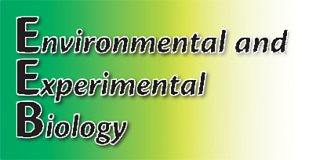
On-line: ISSN 2255–9582

| Faculty of Biology, University of Latvia | ||||||

|
Hard copy: ISSN 1691–8088
On-line: ISSN 2255–9582 Environ Exp Biol (2016) 14: 137–144
|
|||||

|
About the Journal | Retractions | Open Access | Author Guidlines | Current Issue | Archive |
|
Environmental and Experimental Biology |
Environ Exp Biol (2016) 14: 137–144 |
Phytoplankton growth rates are highly dynamic during critical ecological periods, and are of great significance in monitoring programmes as an early warning signal of harmful algal bloom. However, it was still difficult to obtain in situ algal growth rates in a broad spatiotemperal scale. Here we aimed to explore the potential of estimating algal growth rate (AGR) by using a cellular nucleobase-derived ratio. AGR in batch cultures of Microcystis aeruginosa (FACHB-905) was calculated by the daily increment of in vivo chlorophyll fluorescence, and culture cells were collected at different growth phase for nucleobase analysis. The specific growth rate of algae cells was found to increase as a logarithmic function of the molar ratio of uracil to thymine in culture cells, and the inflection point of the fitting curve could be a critical value for the exponential phase of algal growth. In a case study conducted in a large reservoir in Yangtze estuary, AGR was estimated from 0.24 to 0.52 day–1 during a Microsystis-dominated period in October 2014 and one site was recognized at high risk of algal blooming. In conclusion, the ratio of uracil to thymine has potential use in estimating of the AGR, and is promising in the analysis on spatiotemporal dynamics of in situ growth rates of dominant algae.